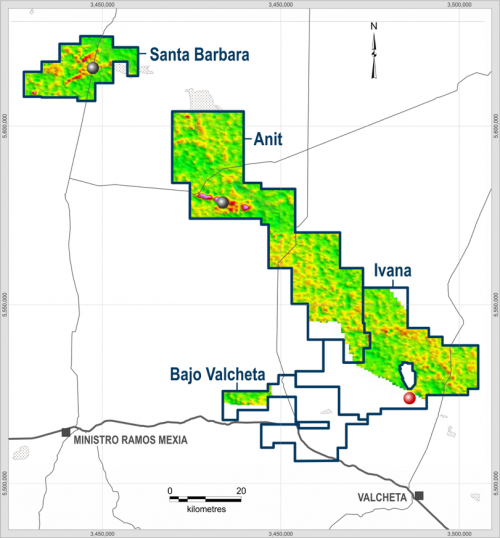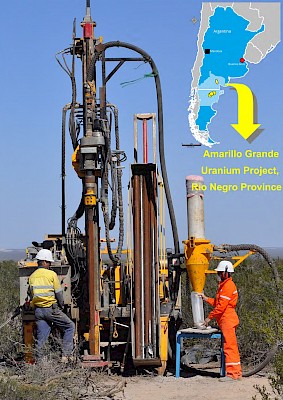Location
The Amarillo Grande Project is located in central Rio Negro province, in the Patagonia region of southern Argentina. The properties are all road accessible from major centres, such as Viedma or Neuquén provincial capitals. The Ivana deposit is located about 25 kilometres north of the Valcheta City, where Blue Sky has a permanent exploration camp/office. The city is located at the junction of Provincial Road #4 and National Road #23, where the latter connects to the deep ocean port of San Antonio Oeste, 120 kilometres to the east. A railway runs parallel to National Road #23, and two high-power lines crosscut the project from east to west.
Exploration & Development Strategy
In the early 2000’s, Blue Sky identified mineralization at Amarillo Grande in multiple targets along a 145 kilometre trend. The uranium is in mainly the form of the leach-amenable mineral carnotite occurring as coatings on pebbles, and is located at or very near surface in unconsolidated to weakly-cemented clastic host rocks. These characteristics make simple and inexpensive open pit mining and leaching a likely development scenario.
In 2016 Blue Sky launched an aggressive exploration program to delineate resources and outline economics at Amarillo Grande with the goal of becoming the first domestic supplier of U3O8 to the growing Argentine nuclear power industry, and a potential international supplier. Rio Negro Province already supports the nuclear industry with several facilities.
With an initial resource estimate and economic assessment complete for the Ivana deposit, and multiple additional exploration targets, Amarillo Grande is now one of the most advanced uranium & vanadium projects in Argentina and has the potential for low-cost mining & processing in a regulatory environment that supports resource development. Blue Sky has secured its first major partner to help move Ivana towards potential production and the Company continues to exploration to build the resource base throughout Amarillo Grande.
Discovery Record
This uranium district was an in-house discovery for Blue Sky. Under the guidance of Dr. Jorge Berizzo, Blue Sky selected Rio Negro as a high-potential location for new uranium deposits. In 2007 the first airborne radiometric survey led to discovery of zones of uranium mineralization at the Anit and Santa Barbara properties. A second large-scale airborne radiometric survey in 2010 led to the acquisition of the Ivana property. Detailed exploration work on all three projects led to the discovery of significant zones of uranium mineralization with potential for expansion to depth and along strike.
Surface exploration, ground geophysics, pit sampling and more than 10,800 metres of drilling were completed since the beginning of the revitalized work program in 2016. On March 5th, 2018 the Company announced its first mineral resource estimate for the Amarillo Grande Project, focused on the Ivana deposit. The Company continued exploration efforts while also completing mineralogical, metallurgical and process test work. On February 27th, 2019 Blue Sky announced the first Preliminary Economic Assessment (“PEA”) for Ivana, as well as an updated mineral resource estimate. The resource estimate included a 19% increase in contained U3O8 and a 13% increase in contained V205, at similar grades. Exploration and drilling continued in and around the Ivana deposit, and on February 22, 2024, Blue Sky announced an upgraded resource estimate that converted 80% of the resources to the Indicated category, and an updated PEA that confirmed the projects potential for a minimum 11-year mining operation. [For additional details please see the Ivana Page]
The PEA is preliminary in nature and is intended to provide an initial assessment of the project’s economic potential and development options. The PEA mine schedule and economic assessment includes numerous assumptions and is based on both Indicated and Inferred mineral resources. Inferred resources are considered too speculative geologically to have the economic considerations applied to them that would enable them to be categorized as mineral reserves, and there is no certainty that the PEA results will be realized. Mineral resources are not mineral reserves and do not have demonstrated economic viability. Additional exploration will be required to potentially upgrade the classification of the inferred mineral resources to be considered in future advanced studies.
The Company considers the exploration potential at Ivana, and within the district-scale 145 kilometre geologic trend, to be high, as has been demonstrated in more mature uranium districts in similar geological environments elsewhere in the world.
Deposit Model, Examples and Project Geology
The Amarillo Grande project hosts mineralization with characteristics of both Surficial and Sandstone-type uranium deposits.
Most of the mineralization found on the properties to date has the characteristics of Surficial Uranium Deposits, in which uranium occurs in sediments or soils of relatively young age (Tertiary to Recent). Surficial deposits typically form in semi-arid to arid uranium rich districts adjacent to uranium source rocks (granites or ash flow sequences) or primary uranium deposits. The main uranium mineral in these deposits is typically carnotite, a yellowish hydrated potassium uranium vanadium oxide, K2(UO2)2(VO4)2.3H2O. Well-known examples of Surficial Uranium deposits include the Langer Heinrich deposit in Namibia and the Wiluna deposit in West Australia.
Uranium mineralization with more Primary-style characteristics is found in the lower section of the Ivana deposit, and makes up a considerable portion of the current resource. Mineralization includes predominantly β-coffinite, plus carnotite, tyuyamunite, liebigite and pyrite. Mineralization is mainly hosted within carbonaceous gray-colored poorly-consolidated sedimentary rocks. This mineralization has considerable similarities to sandstone-hosted uranium deposits in other locations of the world, particularly basal-channel sandstone-hosted uranium deposits, and appears to be related to a redox boundary of possible regional extent. Examples of this style of mineralization can be found in the Powder River Basin of Wyoming, USA; the Coastal Plain of Texas, USA; and Chu-Sarysu and Syrdarya Basins of Kazakhstan; where mappable redox boundaries have been followed for hundreds of kilometres and contain many deposits of this type. Uranium deposits of this type formed along regional redox boundaries can reach large sizes, as at Inkai, Kazakhstan.
Investors are cautioned that there is no assurance that deposits similar in size or grade to these will be found on the Blue Sky properties. The Qualified Person has not verified the information, that is believed to be reliable, concerning these 3rd party deposits.
Regionally, the Amarillo Grande Project, is situated near the boundary between the northwestern North Patagonian Massif (Paleozoic and Mesozoic basement) and the southeastern Neuquén basin. The basement rocks contain units of Neoproterozoic-Cambrian metamorphic rocks, Ordovician to Devonian marine sequences, Permo-Triassic intrusives, and Triassic-Jurassic magmatic-volcanic units. Near horizontal sequences of Late Cretaceous and Tertiary sedimentary and epiclastic volcanic formations, representing the thin distal edge of the Neuquén Basin, lap on to the basement rocks near the Project. Quaternary alluvial-colluvial deposits are widely developed over the Project.
The uranium-vanadium mineralization at Amarillo Grande is hosted mostly in medium to coarse grained poorly consolidated sandstones, minor conglomerates, and mudstones of the lower Chichinales Formation.
There are many possible sources of uranium in the District, including uranium rich-granites, volcanic rocks and, potentially, primary uranium deposits within the underlying Cretaceous sediments. The presence of different potential sources enhances the chances of having uranium available to be mobilized within aquifers and along paleo-fluvial systems to redox front traps where uranium-deposits are formed.
 Figure 1. Regional Geology, Amarillo Grande Project area. Note, exact property outlines not current
Figure 1. Regional Geology, Amarillo Grande Project area. Note, exact property outlines not current
